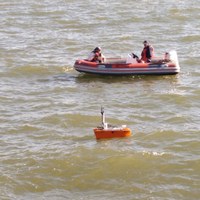First trials conducted as part of project Flexus
A team of researchers from INESC TEC’s Centre for Robotics and Autonomous Systems (CRAS) and Centre for Telecommunications and Multimedia (CTM), have conducted the first trials with a surface vehicle developed as part of project Flexus.
The trials took place between 7 and 9 February, at Arsenal do Alfeite, in Lisbon, a shipyard responsible for the construction, maintenance and repair of vessels. The initiative was supported by the Naval School.
The vehicle operated for several hours, performing remote operations and autonomous missions for two days on the Tagus river. The capacities of the vehicle were thus demonstrated in a real outdoors environment, which collected navigation data and images and worked as a point of contact with the base communication station.
In these first trials, the FLEXUS USV completed over eight kilometres with just one battery charge. The vehicle’s telecommunication system was also tested, connecting the base station and the USV. It was possible to exchange information at a distance of about 550m.

The goal of project FLEXUS - Flexible Unmanned Surface Vehicles for the Internet of Moving Things is to provide a set of ten autonomous surface vehicles, capable of executing missions remotely programmed and downloaded by experimenters on the Internet.
Bruno Ferreira (CRAS) is the project’s technical leader. The project kicked off in September 2016 and has a duration of 30 months.
More information here.
The researcher mentioned in this news piece is associated with INESC TEC.


